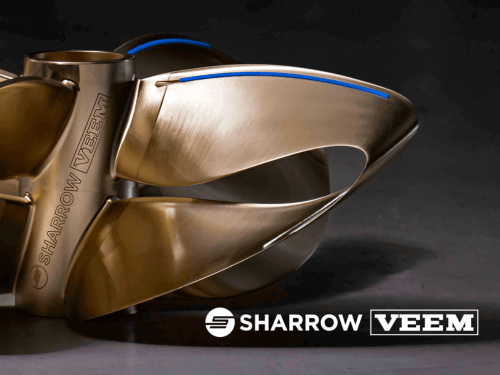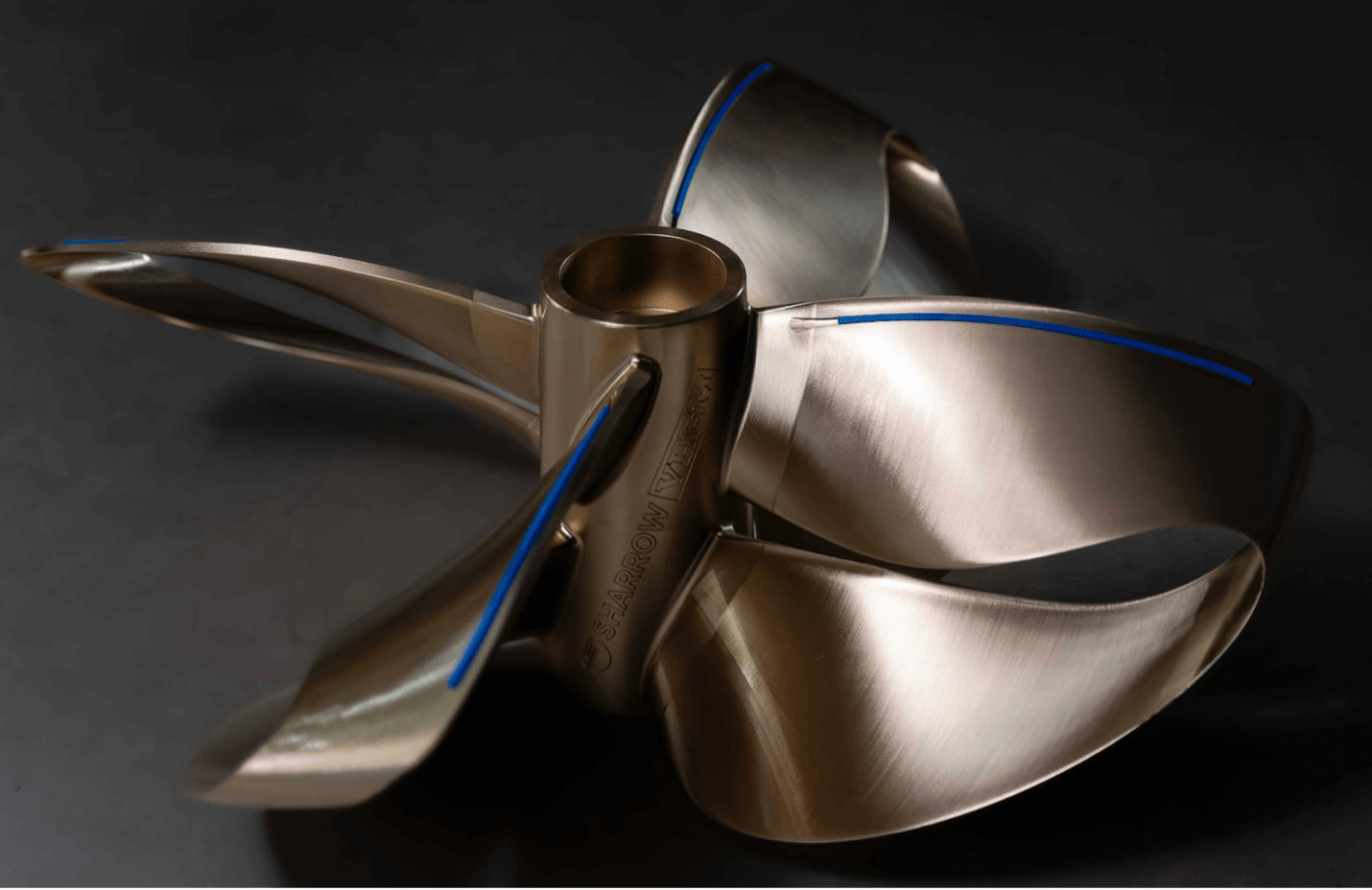Sharrow and VEEM Team-Up To Conquer the Inboard Market

Located in Perth, Australia, VEEM Marine has secured the exclusive global rights to manufacture Sharrow props from 50 cm (20”) to 5 m (16’4”) in diameter. That covers the entire range of inboard recreational yachts, commercial, military vessels and ships up to about 300’ (91 m) worldwide.
The installed base of inboard-powered recreational vessels — including motoryachts of all types and sizes, commercial and military vessels — is estimated to be as many as several hundred thousand. A VEEM spokesman said that it estimates as many as 15,000 new boats are built each year in this category.
Ever since the Sharrow prop was first demonstrated and tested by BoatTEST in August of 2019, readers have asked us when Sharrow would start making props for large motoryachts. The answer was elusive because Sharrow Marine for the last four years has concentrated on the stainless steel outboard engine prop market, with only one exception that we know of.
That exception was a test conducted by Sharrow and the boatbuilder Neptunus, pitting a set of VEEM props (generally considered to be the best of their type) against a pair of Sharrow props on a Neptunus 65. Our report on that test stated that the Sharrow props were 36% more efficient at 10 knots, 58% more efficient at 12 knots, and then down to 9% more efficient at 22 knots. At that point, the VEEM props came into their own and were 7% more fuel efficient at 31 knots.

Why a Licensing Agreement Now?
Greg Sharrow explains: “Moving into the large inboard market has long been a strategic priority for our company. We are certain that bringing the benefits of the Sharrow propeller to the large inboard market has the potential to be transformative. However, designing and manufacturing such large propellers will be extremely complex.”
Making Sharrow props of any size is a difficult and expensive operation. Currently, Sharrow is sourcing its castings from several U.S. foundries, including the Yamaha Motors foundry in Greenfield, Indiana. All castings must then be worked by $500,000 5-axis CNC routers that literally sculpt each prop to a tolerance of a small fraction of a millimeter. Sharrow currently utilizes 11 of these machines that are making outboard props from about 13’’ to 29” in diameter.
So, for Sharrow, entering into a manufacturing agreement with the world’s leader in making the highest-quality large inboard props, was a no brainer. Sharrow said last night, “We knew we needed a partner who shares our commitment to innovation and manufacturing excellence. VEEM was the obvious — and truthfully the best — choice, one that will allow us to quickly scale production, and to do so with uncompromised manufacturing quality.”

VEEM Marine
VEEM propellers came to the attention of Americans in 2001, when the company started exporting its products to satisfy owners of large cruisers and sportfishermen who placed an emphasis on speed. Viking Yachts was one of the company’s first customers in the U.S. and remains so today. VEEM also went to Europe selling its props to brands such as Princess, Sunseeker and most of the other well-know motoryacht builders. VEEM says that they estimate that they have well over 50% of the big yacht market — all the way up to superyachts.
In 2004 VEEM bought its first 5-axis CNC router allowing it to manufacturer any prop design to a tolerance of 20 microns, as well as to make an infinite number of designs all at the same cost. To our knowledge, this was the first time such a tool was used to make a boat propeller.

The Innovative Interceptor
In 2007, after over a year of testing, VEEM introduced its patented “Interceptor” props. By placing a thin strip of plastic in a groove at the trailing edge of the blade, VEEM engineers were able to disrupt the laminar flow of the blade to essentially alter the effective pitch of the prop. These plastic strips come in different colors to identify how far above the surface of the blade they protrude, and they come with a number of different heights. They are effectively a cup in the blade, but unlike conventional cupping, they are not permanent, and can be adjusted for each application.
This innovation had a profound influence on VEEM’s business. Now a builder could order a set of props that engineers thought would be optimum, and if they were wrong, by changing the strips they could alter the prop's effective pitch by as much as 3.5 inches. According to Brad Miocevich, Chairman of the VEEM board, typically builders need only adjust the pitch from .5 to .7 of an inch, to dial in the performance wanted.
If a boatowner wants to be the first out to fishing grounds, he can have a diver put in the “fast” plastic strip. Once the tournament is over and the boat needs to be relocated a considerable distance, another strip can be inserted to maximize fuel economy at moderate cruising speeds.
Miocevich told us that a boat is remarkably sensitive to all sorts of things. For example, adding a tuna tower to a convertible significantly changes the boat’s performance characteristics, and the VEEM Interceptors can improve performance without having to buy a new set of props. Miocevich said that a boat will perform differently in fresh or salt water, in warm water or cold, all of which can be compensated for by changing the Interceptors to optimize performance for the conditions. Also, some engine makers will not certify their engines in a specific application unless they achieve a certain RPM. The Interceptors can reduce the effective pitch allowing the engines to turn from 20 to 50 more RPM, according to Miocevich.
Today, more than 50% of the VEEM props are sold with Interceptors.
VEEM Manufacturing
VEEM Ltd. operates one of the largest non-ferrous and ferrous foundry facilities in Australia with 12 furnaces and 14.3 tonnes capacity. The company has over 50 years of manufacturing experience behind it, and its foundry division is unique in Australia, says the company. VEEM says it has “unique robotic molding techniques” and advanced pattern-making facilities ensure that it can make any component from over 250 alloys.
Once the props are cast, they move to the 5-axis CNC router. Today, VEEM operates such routers that make props at large as 16’ in diameter.
The Details
According to Greg Sharrow, inventor and CEO of Sharrow Marine, VEEM will immediately begin performance testing the Sharrow design on VEEM’s Viking test vessel. This should be completed in a few months, he said. Once VEEM is comfortable with the results, the two companies will work together to produce a state-of-the-art series of “Sharrow by VEEM" propellers for inboard vessels in the 30-90 foot range. Sharrow’s engineers will do the designing, just as they do for the outboard props.
Sharrow said he expects the first “Sharrow by VEEM” propellers to be available in early 2024, with the full range rolled out by the end of next year. “The propellers will Initially be manufactured at VEEM’s facility in Western Australia, with possible expansion to other facilities to be determined down the road,” he said.

Markets for the “Sharrow by VEEM” Props
Because large motoryachts burn such a prodigious amount of fuel, and typically cruise at reasonable speeds — right in the Sharrow props’ sweet spot — their use of Sharrow by VEEM props seems almost a given. They will cost more than conventional VEEM props, an amount which Miocevich says has yet to be determined.
We asked VEEM Chariman Miocevich if he thought sportfishing boats would embrace the Sharrow props because their emphasis is on WOT speed, and answered a resounding “yes.” He said there are three reasons why owners of large convertibles and sportfishing boats will want the Sharrow props: 1. They are extremely strong when backing down and maneuvering backwards; 2. They greatly reduce noise and vibration, much more so than even VEEM props; and 3. Speed — “We think that the Sharrow by VEEM props will be faster!”
Our last questions for Miocevich was one that a number of BoatTEST members have asked the last couple of years: “Can Sharrow props be made for IPS pods?”
His answer was, “Yes.”